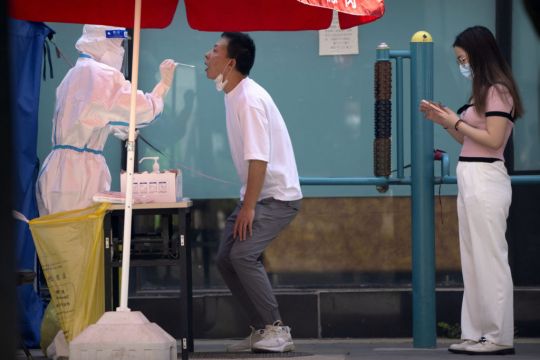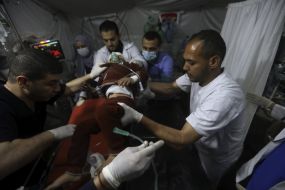China’s capital has closed 60 subway stations – more than 10% of its vast system – as an additional measure against the spread of the coronavirus.
Some 40 stations were closed from the morning and 20 more were added in the afternoon.
The Beijing subway authority in a brief message said only that the mostly downtown stations were being shut as part of epidemic control measures.
No date for the resumption of service was given.
Beijing has been on high alert for the spread of Covid-19, with restaurants and bars limited to takeaways, gyms closed and classes suspended indefinitely.
Major tourist sites in the city, including the Forbidden City and the Beijing Zoo, have closed their indoor exhibition halls and are operating at only partial capacity.

A few communities where cases were discovered have been isolated.
People residing in “controlled” areas have been told to stay within city limits, including 12 areas deemed high-risk and another 35 considered medium-risk.
City residents are required to undergo three virus tests throughout the week as authorities seek to detect and isolate cases without imposing the sort of sweeping lockdowns seen in Shanghai and elsewhere.
A negative test result obtained within the previous 48 hours is required to enter most public spaces.
Beijing on Wednesday recorded just 51 new cases, five of them asymptomatic.
The subway closings should have relatively little impact on city life, with China observing the Labour Day holiday this week and many commuters in the capital of 21 million already working from home.

In one city centre neighbourhood categorised as high-risk on Wednesday, the streets were practically deserted apart from a few delivery drivers on scooters and an occasional pedestrian or car.
All businesses were shut except for supermarkets and fruit and vegetable stores.
Outsiders generally stay away from high-risk areas to avoid the possibility of their presence registering on the tracing apps installed on virtually all mobile phones, creating potential problems for future access to public areas.
While taking a lighter touch in Beijing, China has stuck overall to its strict “zero-Covid” approach that restricts travel, tests entire cities and sets up sprawling facilities to try to isolate every infected person.
Lockdowns start with buildings and neighbourhoods but become city-wide if the virus spreads widely.
That has caused the most disruption in Shanghai, where authorities are slowly easing restrictions that have confined most of the city’s 26 million people to their apartments, housing compounds or immediate neighbourhoods for close to a month, and in some cases longer.

Shanghai reported another 4,982 cases on Wednesday, all but 260 of them asymptomatic, along with an additional 16 deaths.
That continues a steady decline in China’s largest city, which recorded a daily peak of 27,605 new cases on April 13.
The surprisingly low death toll amid an outbreak of more than 400,000 cases in the city that is home to China’s main stock market and biggest port has sparked questions about how such deaths are tallied.
The rigid and widely derided restrictions have led to shortages of food and medical aid along with a wider — though likely temporary — impact on the national economy.
Desperate, outraged citizens have confronted authorities at barricades and online, screamed out of their windows and banged pots and pans in a sign of frustration and anger.
Communist authorities who tolerate no dissent have sought to scrub criticism from the internet and blamed the protests, including the banging of cooking implements, on agitation by unidentified “foreign anti-China forces”.
As part of reopening, Shanghai this week began requiring health institutions to fully resume services wherever possible.

Patients filled the waiting area at the city centre Huashan Hospital with queues forming outside some departments, according to a Shanghai Media Group report.
While patient numbers are down by about two-thirds from before the most recent wave, their conditions tend to be more serious.
Huashan’s deputy director of dermatology, Wu Wenyu, told the Shanghai Media Group he was seeing patients who had delayed treatment because of the outbreak, some from cities outside Shanghai.
“For example, a patient suffering from (skin disease) shingles will hurt very much. He or she might have felt very bad at home, but he or she couldn’t go to the hospital due to Covid,” Mr Wu said. “But now many patients are coming to see the doctor.”
Hospital administrators said the hospital was staggering appointments to avoid crowding.
In some residential communities, a single family member was permitted to venture out twice a week to shop, sometimes also picking up items for neighbours.
Ling Jiazhao, manager of a supermarket in the eastern Pudong district, told the Shanghai Media Group that the store was limiting customers to 50 every half hour.
“I’m hoping it won’t cause congestion. Each community has two to four hours to go out for shopping, so most members will complete that within one hour,” Ms Ling said.







